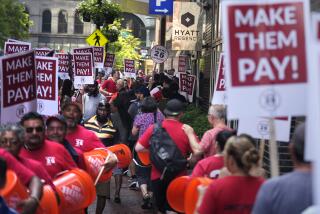Cutting back on housekeepers’ heavy lifting
Some hotel guests may be getting a better night’s sleep these days, but at the expense of the housekeepers who clean their rooms. In what has been called an “amenities arms race,” many hotels now use luxury mattresses that weigh more than 100 pounds each. Multiply those 100 pounds by the 16 to 25 beds the typical housekeeper must make up daily. Add to that the extra pillows to be fluffed, thick duvets and decorative bed skirts to be changed, all without any reduction in the number of rooms each worker is required to clean. It’s not hard to see how this workload can lead to debilitating, often permanent injuries to the back, arm and shoulder and rotator cuff.
Data from the U.S. Bureau of Labor Statistics show that hotel workers have markedly higher injury rates than other service industry workers on average: 5 injuries per 100 workers, while the average for all service industries is about 3.4 injuries per 100 workers. A 2009 report in the American Journal of Industrial Medicine found that housekeepers have higher (7.87 per 100) injury rates than other hotel workers, including banquet servers (2.82 per 100), dishwashers (5.97 per 100) and cooks (5.99 per 100). Ergonomics experts in 2006 at Ohio State University found that housekeepers had a higher risk of back injury than autoworkers who assemble car doors.
Many of the injuries are preventable. The state Senate has passed a bill proposed by Sen. Kevin de Le?n (D-Los Angeles) that would help prevent or reduce housekeeper injuries. It comes up for a vote in the Assembly this month. The bill, SB 432, would require hotels to use fitted sheets instead of flat sheets to reduce the amount of mattress lifting housekeepers must do. That is no small change if you consider how many hundreds of pounds a day that involves. The legislation also would require hotels to provide long-handled mops so housekeepers won’t have to clean bathrooms on their hands and knees as they do now.
But the bill is facing stiff opposition from the hotel and tourism industry, which says it will increase costs and stifle growth. A representative of the hotel industry, led by the California Hotel and Lodging Assn., told a Senate Committee that if SB 432 passes, California hotels will have to spend an additional $15 million or more to buy fitted sheets to replace the sheets for 550,000 beds at $25 per sheet. But hotels generally replace their sheets annually, so isn’t this the price of normal operations, especially since the new law would be phased in? Even if these figures are accurate, it’s a drop in the bucket for the $47-billion industry. Is this too much to spend to save years of debilitating back pain and injury for thousands of California workers? The industry’s knee-jerk opposition ignores the millions they could save in workers’ compensation costs because of fewer injuries.
Industry representatives say hotels are already taking good care of employee health and safety, so there’s no need for a law. Of course, they also claim the bill is a “job killer” — the favorite label business lobbyists use to frighten politicians and the public from supporting laws that protect workers, consumers and the environment.
Haven’t we heard similar warnings before?
Forty years ago, California’s farmworkers were forced to stoop eight to 12 hours per day with short-handled hoes tending to lettuce and other crops. After only a few years in the fields, most workers suffered from chronic and debilitating back injuries.
In 1972, the nonprofit California Rural Legal Assistance petitioned the Industrial Safety Board of the state Division of Industrial Safety (since replaced by the Cal-OSHA standards board) to prohibit the use of el cortito, as the short hoe was known in the fields. The California Rural Legal Assistance argued that farmworkers should be allowed to use a long-handled hoe to reduce back injuries.
The growers predicted economic disaster. Lettuce growers were among the loudest opponents. Hector de la Vega, a lettuce grower from Calexico, testified in 1973 to the Industrial Safety Board that California would “absolutely do away with the industry if the short-handled hoe was outlawed.” Another lettuce grower, Tom Merrill of Salinas, testified to the board in 1975 that the ban would result in reduced production, which would lead to a “total loss of food crops of monumental proportions.” Attorneys for Salinas-based Bud Antle Inc., the largest lettuce grower in the world at the time, argued that banning the short-handled hoe would be disastrous, leading to fewer crops and higher prices.
In 1975, the safety board rejected a ban on el cortito, but California Rural Legal Assistance appealed the decision. The state Supreme Court subsequently ruled against the agribusiness lobby. Soon after Jerry Brown become governor (the first time), the state Division of Industrial Safety banned the short-handled hoe.
The growers’ dire predictions proved wrong.
Today, California’s $30-billion agriculture industry is the world’s fifth-largest supplier of food and agricultural commodities. Lettuce production and revenue have steadily increased since 1975, when the hoe was banned. As of 2010, more than three-quarters of all U.S.-grown lettuce is produced in California. And the number of agricultural workers in California has steadily increased since the ban.
Even growers admitted they were wrong. Robert Antle, president of Bud Antle, told the San Francisco Chronicle in April 1975, “We fought this thing and worried about it and now it turns out not to be a problem.”
Today, the hotel industry is predicting the same economic havoc if housekeepers get the kind of protections farmworkers got 35 years ago.
The agriculture industry was wrong then, and the hotels are wrong now. The tourism industry will continue to grow and it will need healthy workers. The Assembly should pass SB 432, and the governor should sign it.
Donald Cohen is the director of the Cry Wolf Project, a nonprofit research network that identifies and exposes misleading rhetoric about the economy, regulation and government.
More to Read
A cure for the common opinion
Get thought-provoking perspectives with our weekly newsletter.
You may occasionally receive promotional content from the Los Angeles Times.










